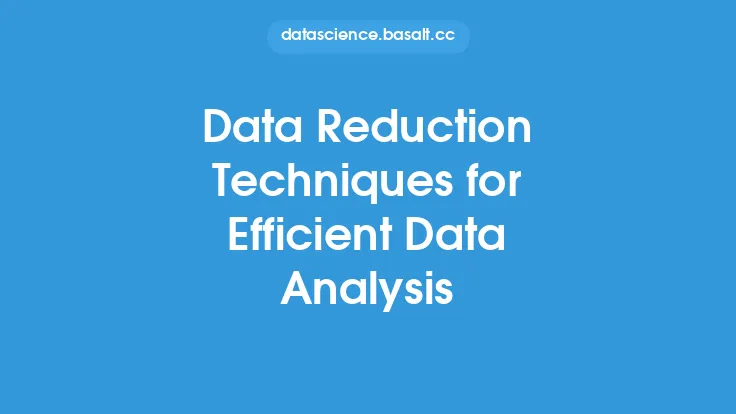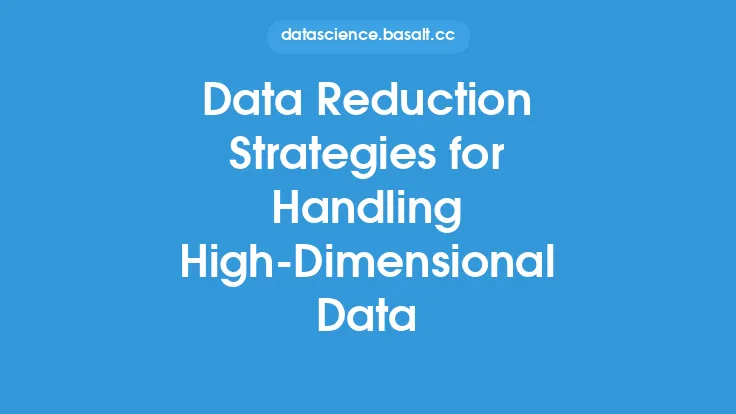Data reduction is a crucial step in the data analysis process, as it enables analysts to simplify complex data sets, reduce noise, and improve model performance. Effective data reduction techniques can help to identify the most important variables, eliminate redundant or irrelevant data, and improve the overall quality of the data. In this article, we will explore various techniques for effective data reduction, including data preprocessing, feature selection, and dimensionality reduction.
Introduction to Data Reduction Techniques
Data reduction techniques can be broadly categorized into two main types: feature selection and dimensionality reduction. Feature selection involves selecting a subset of the most relevant features or variables from the original data set, while dimensionality reduction involves transforming the data into a lower-dimensional space. Both techniques can be used to reduce the complexity of the data, improve model performance, and reduce the risk of overfitting. Some common data reduction techniques include principal component analysis (PCA), singular value decomposition (SVD), and independent component analysis (ICA).
Data Preprocessing for Effective Data Reduction
Data preprocessing is an essential step in the data reduction process, as it helps to clean and transform the data into a suitable format for analysis. Data preprocessing techniques include handling missing values, data normalization, and data transformation. Handling missing values involves replacing or imputing missing values with suitable alternatives, such as mean or median values. Data normalization involves scaling the data to a common range, usually between 0 and 1, to prevent features with large ranges from dominating the analysis. Data transformation involves transforming the data into a more suitable format, such as converting categorical variables into numerical variables.
Feature Selection Techniques
Feature selection is a crucial step in the data reduction process, as it helps to identify the most relevant features or variables from the original data set. Some common feature selection techniques include filter methods, wrapper methods, and embedded methods. Filter methods involve selecting features based on their correlation with the target variable, while wrapper methods involve selecting features based on their performance on a model. Embedded methods involve selecting features as part of the model training process. Some popular feature selection algorithms include recursive feature elimination (RFE), least absolute shrinkage and selection operator (LASSO), and random forest feature selection.
Dimensionality Reduction Techniques
Dimensionality reduction is a powerful technique for reducing the complexity of high-dimensional data sets. Some common dimensionality reduction techniques include PCA, SVD, and ICA. PCA involves transforming the data into a new set of orthogonal features, called principal components, which capture the majority of the variance in the data. SVD involves decomposing the data into three matrices, U, Σ, and V, which can be used to reduce the dimensionality of the data. ICA involves transforming the data into a new set of independent features, which are mutually independent.
Advanced Data Reduction Techniques
Some advanced data reduction techniques include non-negative matrix factorization (NMF), latent Dirichlet allocation (LDA), and autoencoders. NMF involves decomposing the data into two non-negative matrices, which can be used to reduce the dimensionality of the data. LDA involves modeling the data as a mixture of latent topics, which can be used to reduce the dimensionality of the data. Autoencoders involve training a neural network to compress and reconstruct the data, which can be used to reduce the dimensionality of the data.
Evaluating the Effectiveness of Data Reduction Techniques
Evaluating the effectiveness of data reduction techniques is crucial to ensure that the reduced data set is representative of the original data set. Some common evaluation metrics include mean squared error (MSE), mean absolute error (MAE), and R-squared. MSE and MAE involve measuring the difference between the original and reduced data sets, while R-squared involves measuring the proportion of variance explained by the reduced data set. Other evaluation metrics include clustering metrics, such as silhouette score and calinski-harabasz index, which involve measuring the quality of the clusters in the reduced data set.
Conclusion
Effective data reduction techniques are essential for simplifying complex data sets, reducing noise, and improving model performance. By applying data preprocessing, feature selection, and dimensionality reduction techniques, analysts can identify the most important variables, eliminate redundant or irrelevant data, and improve the overall quality of the data. Advanced data reduction techniques, such as NMF, LDA, and autoencoders, can be used to reduce the dimensionality of high-dimensional data sets. Evaluating the effectiveness of data reduction techniques is crucial to ensure that the reduced data set is representative of the original data set. By applying these techniques, analysts can unlock the full potential of their data and gain valuable insights into their business or organization.





